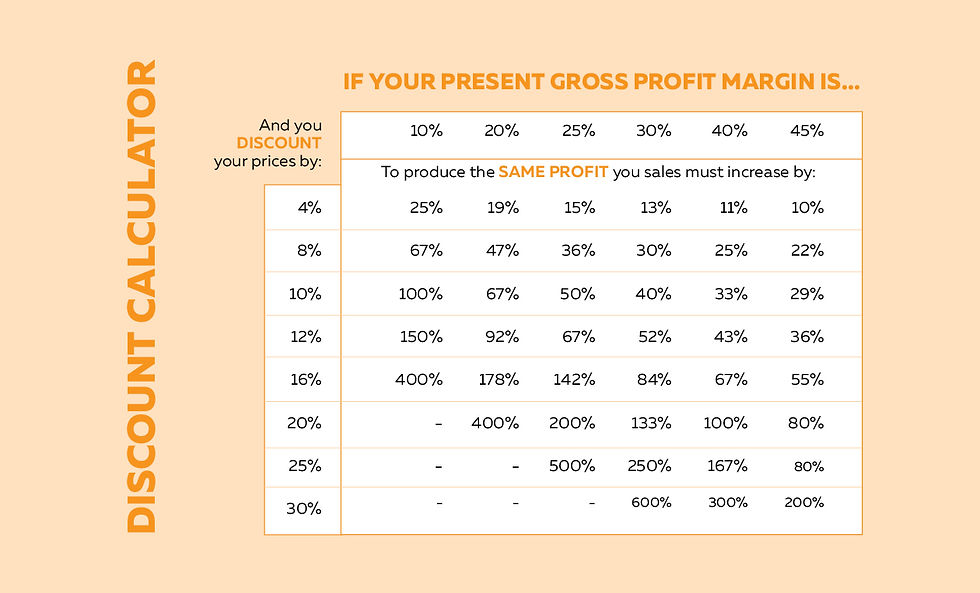Discounting: Strategic move or mistake?
- NZ Landscaper
- Mar 1, 2024
- 5 min read
Updated: Nov 19, 2024

What’s the best move to make when work is thin on the ground – should you discount your pricing or hold firm? Daniel Fitzpatrick from The Next Level Tradie is here to answer that age-old question
Are you finding yourself struggling to secure enough work for your team? Or maybe you've noticed that the amount of confirmed work booked ahead is shrinking. When work starts to dry up, it affects your bottom line. Do you start discounting to get the work, or wait it out until things get better?
It's a situation some tradies are facing right now, and it's not easy. But before you start slashing prices, here are a few things to consider.
Disappearing profit
Profits and margins can disappear alarmingly quickly once you start cutting your prices, and here's why. Let's say your gross profit margin is around 20%. If you reduce your prices on a job by 10%, the volume of work you need to complete, just to maintain the same dollar profit, increases significantly.
For example, if your break-even point is $100,000 per month at a gross profit margin of 20%, and you reduce your prices by 10%, you now need $200,000 of work to reach break-even.
That’s twice the work, time, and effort, for the same result you were previously getting.
It's a stark reminder that while reducing prices might seem like a viable strategy to attract more jobs, the impact on your bottom line can be significant. Not only does it increase your workload, it also puts a strain on you and your team, sometimes compromising quality. Too many rushed jobs that go wrong can also affect your reputation.
So, before you consider cutting your rates, crunch the numbers and understand the real impact on your business' profitability.
Target gross margin
Understanding your target gross margin is crucial in determining which jobs are worth your effort.
Your target gross margin is the percentage of profit you aim to make on each job after all direct costs, including wages, are subtracted. This margin should be high enough to cover your business' overheads plus a healthy profit.
Target gross margin could be anywhere between 20- 60%, depending on the trade and your position in the market. I don't like to see anything under 20% minimum in any trade; less than 20% is too difficult to make a profit. If you want some help to work out your target gross margin and where you should be for your business, then check out the 'Pricing Strategy Session' at the end of this article.
Having a clear target gross margin is like having a compass in the wilderness. Once you know where you want to head, you can see clearly if you are going in the right direction and adjust. No more wasted money, time, or energy taking jobs that lose you money.
Stick to your guns
Your large client wants a better price, what now? Don't just take this at face value. Test, question, negotiate. Why do they think the price is too dear? Are they comparing apples with bananas? Is there more in their budget, or can you adjust the brief to fit?
Show them that your price is good value and see what happens next. Some will get it and some won't. That’s ok. For the ones that don’t get it, don’t be scared to cut your losses and move on to the next opportunity.
An old mentor of mine, Eddie, would tell me that 15% of customers will always go for the cheapest option “no matter what”.
If another option is $1 cheaper, they will take it, even if the job is half as good. The clients you want are the other 85%, who care about getting a quality job done right, hassle-free and are prepared to pay for it.
Remember, pricing isn't just about numbers; it's a mind game. The right way you present your pricing and value can make all the difference in attracting the right kind of clients and getting the work.
When my clients start telling me they are sticking to their rates, that margins are increasing, and they have plenty of good work lined up, so they don’t need to take any job that comes their way, I know they’re on track.
Fishing in the right river
is about being in the right place at the right time. The right bait at high tide will catch way more fish than at low tide when there are no fish around.
It's the same with your business. Are you marketing in the right places? Are you seen as a specialist or a generalist, who does a bit of everything? The specialist attracts better clients and can charge more. That's less work and more profit for you.
Cheapest is dangerous
If your business is based on being the cheapest, that’s a problem. Firstly, you won't be getting the margins you need and there will eventually be someone else out there who will do it even cheaper.
A client of mine, Caleb from The Decking Guys, was in the same predicament. He was working 80 hours per week, making no money, with one part-time employee, and struggling to find work. His clients kept asking him for lower rates. I told him to put his rates up and start specialising. Within 12 months he had a team of 11 and plenty of work. Check out his story on our testimonial page at nextleveltradie.co.nz
More options, better odds
If you are relying on getting one quote, or you can’t pay the bills, you need the job, so the pressure is on you. You are in a weak position and are more likely to cave on price to get the work. A much stronger position would be if you have five other quotes you are following up in the same week with 3-6 months of work already confirmed. Now you're calling the shots.
If a new client is relying on a small number of quotes and doesn't have enough work, the first thing we do is help them get their pricing right and find better jobs. This takes the pressure off and puts them back in control of their business.
Don't waste a good opportunity!
If things are on the quiet side and you’re still not getting the work you want, this could be the opportunity to consolidate and scale back a little, move on any bad eggs and rebuild stronger. Better to have a bit less work for a while rather than working your tail off and going backwards.
If you still want to reduce your rates to pay the bills, then ok. But make sure that this is a short-term strategy and use it as motivation to position the business better, so that you’re not caught out next time. Sometimes in a downturn, there will be less work for a while. The key here is to keep the business solid and profitable while looking for better opportunities – which, long term, is not cutting prices.
Worried that your pricing isn’t right compared to others in your industry, or need to get more profitable work? Book our free 45-minute Pricing Strategy Session.


Trades business coach Daniel Fitzpatrick has been helping tradies increase profits and win back their weekends since 2010.
Worried about your pricing? Book a free Pricing Strategy Call with Next Level Tradie director Daniel Fitzpatrick here: nextleveltradie.co.nz/nextstep



